Getting the Best Out of External Recorders
LONDON—Recording is central to the broadcast workflow, and external recorder manufacturers have been building on their expertise to reach into other areas of acquisition, most notably by developing their own cameras.
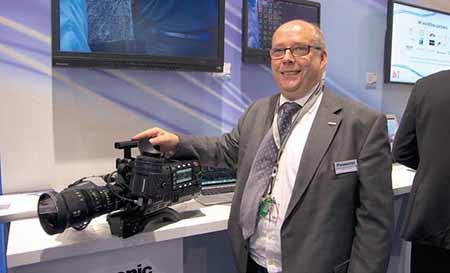
Panasonic’s Varicam 35 and Codex V-Raw recorder
Five years after it launched its Ki Pro recorders, AJA has built on its recording expertise, particularly with the 4K Ki Pro Quad, by adding a camera front end to produce the new Cion, just as Blackmagic Design did previously with its family of cameras, and Codex has also done with its new Action Cam.
However, it is as an add-on, designed to bring out the best in existing cameras, improve workflow and provide secure backup copies, that is still the core of the external recorder market.
For example, London-based Codex has partnered with Arri and Panasonic on their new high-end cameras. It developed the recording and workflow system for Arri’s Alexa 65 large format camera, creating a high-performance, built-in recorder, as well as on-set data management. Current Alexa XR Capture Drives record at up to 24 fps, and a 512 GB media card records about 10 minutes in the 65’s full open gate mode. Next-generation Capture Drives developed by Codex will offer 2 TB capacity, at 20 Gbps data rates, to record more than 45 minutes. Codex now also delivers ProRes UHD workflows for Arri’s Alexa and Amira, via Vault and the Codex CFast 2.0 dock for the Amira.
Panasonic developed a recorder for the new VariCam 35 camera that will capture 12-bit uncompressed 4K Raw at up to 120 fps, and will work with Arri LDS or Cooke/i technology for lens data capture. Rapid transfer of digital camera originals for post production and archiving is then possible using Codex Vault.
The compact, 2.2-pound V-Raw recorder connects directly to the back of the VariCam 35, eliminating cabling for improved efficiency and greater mobility.
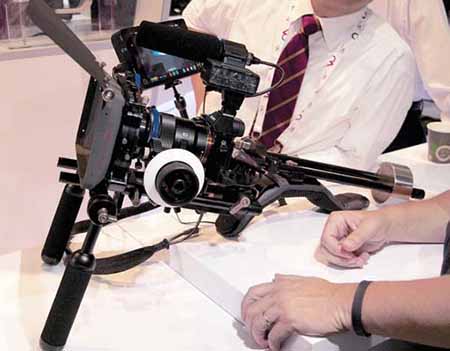
Sony’s A7s full-frame DSLR with Atomos recorder
“The recorder is about the practicalities and the workflow,” said Rob Tarrant, Panasonic’s European product manager. “Its ability to do multiple formats simultaneously is a big advantage, as it [allows the camera to record] up to four at once.” Besides Raw, it can record 4K compressed using AVC Ultra onto Express P2 cards, and 2K and 1K proxies on to the same microP2 card. For a broadcast workflow it will do uncompressed Ultra HD, compressed UHD, HD and 960x540 proxies at once.
Why so many? Tarrant responds, “obviously Raw is a vast amount of data, but this gives you the ability to create dailies in the camera, with the same metadata, etc, so users can instantly start an offline edit. There is also in-camera grading, saving further time in post.”
Codex has also added support in its Vault workflow system for the Red Epic Dragon and Vision Research Phantom Flex4k cameras, while Panasonic has introduced its own 50/60p AJ-PG50 AVCUltra recorder with 3G HD-SDI and HDMI input, which offers dual-codec recording to one P2 and two micro P2 card slots. The AJ-PG50 also has full network capabilities and can make backup copies to USB 3.0 drives.
4:2:2 AND RAW SUPPORT
External recorders have a particular niche in the world of DSLRs, where it is often the only way of getting high-quality results. Nikon’s new video-focused D810 and D750 full-frame cameras offer full 4:2:2 HD recording at up to 50/60 fps via a clean HDMI feed, while Sony’s A7S full-frame DSLR, which has been lauded for its low-light capabilities, also requires an external recorder to record its 4K 4:2:2 output.
It’s not only DSLRs that benefit. Sony’s new PXW-FS7 4K XDCAM camcorder can record up to 180 fps internally in HD, but up to 240fps to an external recorder, which it also requires if you want to record 4K as 12-bit linear Raw output (it can do up to 4K/UHD XAVC Intra 4:2:2 10-bit at 600 Mbps internally). It needs the optional XDCA-FS7 extension unit to output the Raw video, recording to Sony’s own AXSR5 recorder via the HXR-IFR5 interface or the Convergent Design Odyssey 7Q (the XDCA-FS7 also allows ProRes recording internally).
Sony has also introduced its own XDCAM portable recorder. The lightweight PMW-RX50 records to dual SxS cards and supports the XAVC Intra 4:2:2 1080 50/60p and XAVC Long GoP 4:2:2 formats, as well as MPEG HD 4:2:2, 4:2:0, MPEG IMX and DVCAM. However, it is designed more as a deck replacement, with a built-in 3.5-inch screen for reviewing video, than an on-camera device.
PRORES GOES ON ODYSSEY
The Odyssey7Q monitor/recorder from Colorado Springs, Colo.-based Convergent Design, has now added 4K recording using Apple’s ProRes 422 HQ, and will record 4K and UHD video from the Sony F55, Panasonic GH4, Phantom Flex4K and others, which can be converted to ProRes. Because of the codec’s efficiency, it will be able to record many hours of 4K to the dual SSDs.
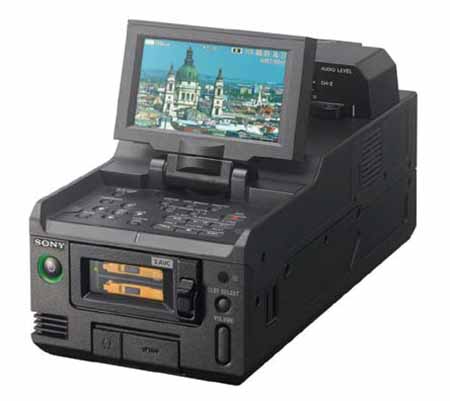
Sony PMW-RX50 XDCAM portable recorder
The Odyssey7Q already supported 4K Raw from Canon’s C500 and Sony’s FS700 (and adds the new FS7). These are also being upgraded to support ProRes to more than triple the recording time of Raw.
The Odyssey7Q now also functions as a 4K waveform and histogram (with RGB Parade). Its Pixel Zoom function allows the 7.7-inch OLED display to function as a virtual window for accurate focus on an image equivalent to a 24-inch 4K monitor. It can act as a format converter, transforming 4K input into multiple 1080p HD outputs for monitoring and transmission around the set, and process a camera’s Log signals while applying an appropriate look-up table to its display and outputs.
The new $1,295 Odyssey7 monitor/ recorder is the 7Q’s little sister (for about $1,000 less). It can capture HD in Apple ProRes 422 (HQ) up to 1080/30p, 1080/60i and 720/60p, with future free updates promised to expand these frame rates and add other formats. It has one SSD slot, and both SDI and HDMI outputs.
Convergent Design has also developed the Athena 4K/multi-stream player/recorder encoder/decoder, which will support up to 4K 60p and multiple-streams (even in 4K). According to the company, it is the first system with the ability to record/ play four HD video streams along with 64 channels of MADI audio, and would be useful as a live event multi-camera recorder; multiple units can be ganged together for large-scale events. The half-rack 1RU system will have an LCD display for status information and confidence monitoring, a 2.5-inch SSD slot and deck controls.
ON DECK
Like the Athena, Cinedeck’s recorders are also primarily deck replacements. Its new MX4K can record two 4K or Ultra HD sources, and its MX can handle a 4K YUV10 input from sources like a Sony F55, while simultaneously creating edit-ready HD Master and Proxy deliverables, plus streamable H.264 files, while maintaining global file naming and metadata. It also downconverts 4K camera feeds in realtime for HD monitoring.
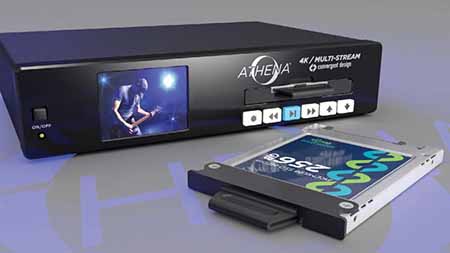
The Athena is the latest in Convergent Design’s recorder line-up.
The 4K, HD Master and Proxy files are all recorded to removable SSD drives, with edit-ready deliverables simultaneously written to SAN for immediate access, and can be encoded to the full gamut of available codec and wrapper profiles. Users can apply a variety of standard or custom LUTs to the proxy, H.264, on-board display and HD outputs.
There is also a new modular Cinedeck ZX rack-mount line: the ZX20 provides two channels of 2K, HD or SD, with optional 4K playback; the ZX40 delivers four channels of 2K, HD or SD, and, when fullyloaded with plug-in packages, is equivalent to the 4K-capable Cinedeck MX; and the ZX45 supports 4K and UHD at 50/60p and four channels of 2K, HD or SD at 50/60p, including visually lossless JPEG2000. Users can choose codec and wrapper packages to support Avid, Apple and Adobe workflows, and others. This “means you build what you need, and only pay for that functionality, while still having the option to add a wide range of features and functions should your workflow change,” said Charles D’Autremont, founder and CEO of Cinedeck in New York.
CUTTING-EDGE
Since first being shown at NAB, the new Atomos Shogun has been refined further, and now “has a new heat pipe system, to allow us to crank up the frame rate to 4K 50/60p,” explained Jeromy Young, CEO and founder of the Australianbased company.
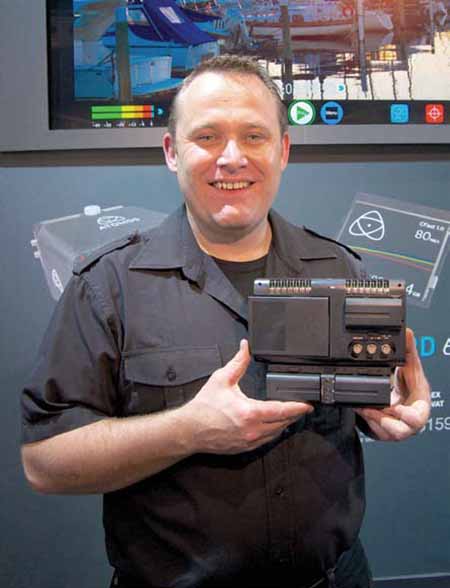
The Atomos Shogun and add-on Power Station
Atomos has also become “one of the first adopters of 12G-SDI,” which will be necessary if 4K and Ultra HD are to be able to use just a single cable. Shogun also has 6GSDI and 3G-SDI input, as well as genlock in, HDMI 2.0 I/O, and a Lemo connector (with included breakout cable) for balanced analog XLR audio input and Phantom power, plus 12 channels of digital audio. It is ideal for use with 4K DSLRs, such as the Sony A7S and Panasonic GH4. Indeed, Atomos has worked with camera manufacturers to add SDI-like features (such as auto triggering and timecode communication) to HDMI, so that the Shogun can control Sony and Canon DSLRs (and Canon EOS cameras) via HDMI.
It costs $1,995 and records 4K ProRes, Raw or Avid DNxHD formats, as well as high frame rate HD (up to 120 fps), and has a 1920x1200 SuperAtom IPS 7-inch touchscreen for monitoring and control.
Unlike the Samurai and Ninja Blade, Shogun only has a single battery (as the space for a second was occupied by the SDI connectors and SSD array), so users wanting continuous power will need to add the newly launched Atomos Power Station, with its hot-swappable batteries.
At the other end of the scale, Atomos has introduced the world’s smallest 10- bit 4:2:2 ProRes recorder, the Ninja Star, a flash-based device ideal for extreme applications, such as on remote-control helicopters, or with point-of-view cameras.
The $295 unit has no monitor, but weighs only 8.8 ounces with the included battery and a low-cost Gen 1 CFast solidstate memory card. It has HDMI input, and its flexible mounting options should allow users to mount it to just about any POV setup. It offers frame accurate timecode (via HDMI) and Start/Stop Trigger.
Get the TV Tech Newsletter
The professional video industry's #1 source for news, trends and product and tech information. Sign up below.
